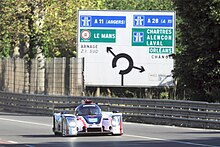TheMulsanne Straight(French:Ligne Droite des Hunaudières,"Straight Line of Les Hunaudières" ) is the name used in English for a formerly 6 km (3.7 mi) long straight of theCircuit de la Sarthearound which the24 Hours of Le Mansauto race takes place. Since 1990, the straight is interrupted by twochicanes,with the last section (that includes a slight right turn known as the "Kink" ) leading to a sharp corner near the village ofMulsanne.Before the chicanes were added, the Mulsanne Straight was the longest straight section of any race track in the world.[1]


French name
editWhen races are not taking place, the Mulsanne Straight is part of the national road system of France. It is called theLigne Droite des Hunaudières,a part of theroute départementaleRD 338 (formerlyRoute NationaleRN 138) in theSarthedepartment.TheHunaudièresleads to the village ofMulsanne,its English namesake (though the FrenchRoute de Mulsanneis the name for the road between Mulsanne andArnage,with theIndianapoliscorner in between).[2]
History
editDuring the1911 Grand Prix season,the Grand Prix de France used an early version of the Circuit de la Sarthe, which was 54 km in length, and used a longer version of the current straight, running from Ave George Durand at Le Tertre Rouge, toÉcommoy,before heading towardsSaint-Mars-d'Outillé,Les Jouanneries andParigné-l'Évêque.
The circuit (and straight) were shortened in 1921. After exiting theTertre Rougecorner, cars would spend almost half of the lap at full throttle, before braking for the right-hand Mulsanne Corner. ThePorsche 917longtail with its 4.9-litreflat-12 engine,used from 1969 to 1971, had reached 362 km/h (225 mph).[3]After this, engine size was limited and top speeds dropped until powerfulturbochargedengines, pioneered at Le Mans by manufacturersRenaultandPorsche,were allowed, as in the 1978Porsche 935which was clocked at 367 km/h (228 mph).[4]
Speeds on the straight byGroup Cprototypesreached over 400 km/h (250 mph) during the late 1980s. At the beginning of the1988 24 Hours of Le Mansrace,Parisgarage ownerRoger Dorchydrove forWelter Racingin a car dubbed the WM P88. The P88 belonged to a program known as "Project 400" and was powered by a 2.8-litre turbochargedPeugeotPRV V6 engine,which sacrificed reliability for power. As a result, the car wasoutafter just 53 laps (or approximately 4 hours) with turbo, cooling and electrical failures. It was measured by radar travelling at an all-time race record speed of 405 km/h (252 mph).[3][1]
There were several fatal high-speed accidents on the Mulsanne Straight in the 1980s.Jean-Louis Lafossewas killed in1981,andJo Gartnerin1986;in1984a French track marshal was killed in an accident at the Kink involving the twoAston MartinNimrod NRA/C2sof British driverJohn Sheldonand his American teammateDrake Olson.[5]One driver had an extremely lucky escape in 1986: a tyre on British driverWin Percy's 7.0 litreV12-poweredJaguar XJR-6exploded at 386 km/h (240 mph), tearing off the rear bodywork and flipping the car into the air "up above the trees".[6]The wreckage finally came to a halt 600 metres down the road. Although the vehicle was almost obliterated, Percy somehow walked away from the crash with nothing more than a badly battered helmet.
Addition of chicanes
editThe 6km (3.7 mi) Mulsanne Straight caused tyre and engine failures, as cars reached over 320km/h (200mph) before braking hard for the sharp right turn at its end. So twochicaneswere added to the straight beforethe 1990 raceto limit the achievable maximum speed[7]and because theFIAdecreed it would no longer sanction a circuit with a straight longer than 2 km (1.2 mi),[8]which is roughly the length of theDöttinger Höhestraight on theNürburgring Nordschleife.Since their installation, most leading cars have topped out around 330 km/h (205 mph) during qualifying and 320 km/h (199 mph) during the race.
The highest speed on the Straight since 1990 was achieved by aNissan R90CKdriven byMark Blundell,which reached 366 km/h (226.9 mph) during qualifying when thetwin-turbosystem'swastegatewas stuck shut, leading the engine to produce well over its regular output of 800 bhp.
This articlepossibly contains unsourcedpredictions,speculative material, or accounts of events that might not occur.Information must beverifiableand based onreliable published sources.(August 2021) |
The exact power increase remains unknown.[9][better source needed]
Spectator access
editIn the past, spectators could obtain magnificent views of cars racing along the straight during the Le Mans, including while dining at various restaurants—such asRestaurant de 24 HeuresandLes Virages de L'Arche—located very close to the road. However, in 1990, the viewing experience obtained at both restaurants was diminished with the introduction of the chicanes.[10]
Today, due to safety concerns, spectators are kept well away from the edge of the straight by marshals and police, and while dining guests can still hear the cars pass, their view is obscured by green covers attached to the safety fencing.[11][12]
Namesake
editThreeBentleycars are named after the straight and nearby villages: theMulsanne,theArnage,and theHunaudièresconcept car.
GM offered its 1970 Corvette in a color named Mulsanne blue.
References
edit- ^ab"What's the Speed Record on the Mulsanne Straight?".Motorsport Explained.2022-03-02.Retrieved2022-07-29.
- ^Hergault 2011.
- ^abFuller 2010.
- ^Leffingwell, Randy (2005).Porsche 911: Perfection by Design.Motorbooks. p. 155.
- ^"1984 - Le Mans — John Sheldon's massive crash".YouTube.Archivedfrom the original on 2021-12-21.Retrieved10 September2011.
- ^"Win Percy".Gear Wheels.Archived fromthe originalon 2002-01-02.Retrieved2016-07-26.
- ^Speedhunters staff 2008.
- ^RC staff 2015.
- ^Pruett, Marshall (January 19, 2017)."How a Broken Turbo Gave this Nissan 1000+ Horsepower and Nearly Set a Speed Record".Road & Track.RetrievedSeptember 7,2019.
- ^MSM staff 1990.
- ^Bonardel 2015.
- ^RT staff 2015.
Bibliography
edit- Hergault, Julien (2011-08-04)."The Highway of Records".lemans.org.Archivedfrom the original on 2019-08-14.Retrieved2019-08-14.
- Bonardel, Cécile (2015-04-09)."24 Hours of Le Mans - The legendary spots on the circuit: The Mulsanne Straight".lemans.org.Archivedfrom the original on 2019-07-03.Retrieved2019-08-14.
- Fuller, Michael J. (2010),"Mulsanne's Corner: Maximum Speeds at Le Mans, 1961-1989",Mulsanne's Corner, technical analysis of contemporary sports prototype racing cars,retrieved25 July2015
- MSM staff (June 1990),"Le Mans Spectator Guide",Motor Sport Magazine Archive,retrieved25 July2015
- RC staff (2015),"Le Mans",RacingCircuits.info,retrieved25 July2015
- RT staff (2015),"Eating & drinking at Le Mans",Race Tours,archived fromthe originalon 6 September 2012,retrieved25 July2015
- Speedhunters staff (13 June 2008),"Temple Of Speed>> The Mulsanne Straight",Speedhunters,retrieved25 July2015